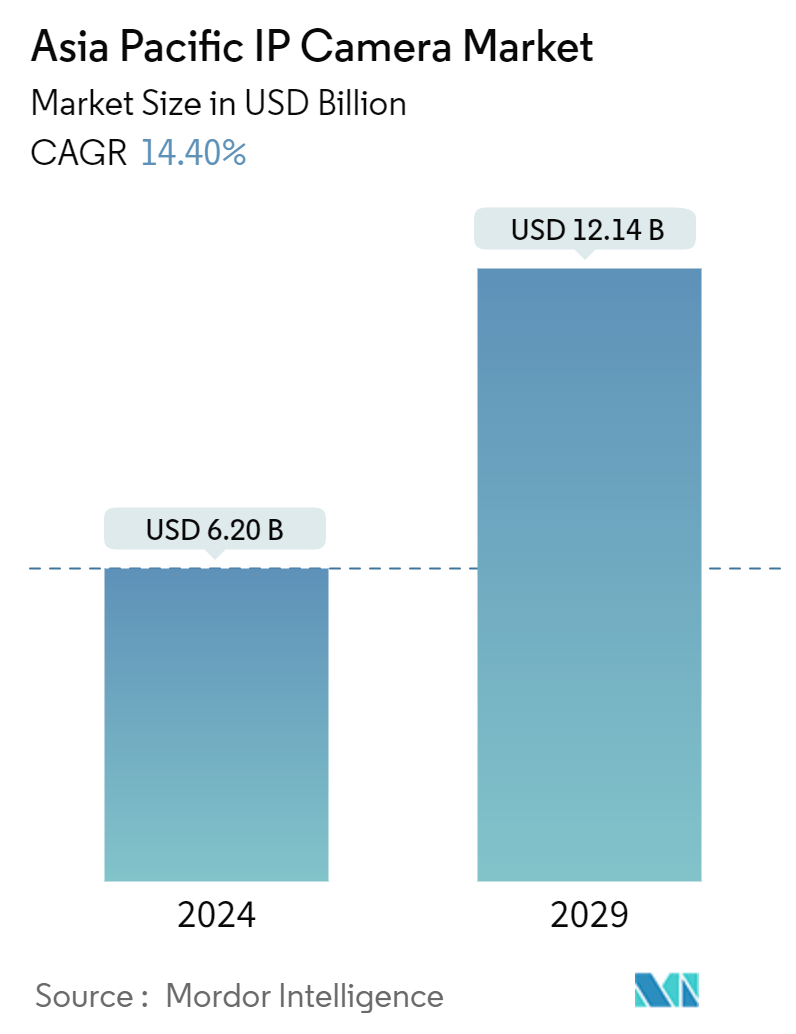Market Size of Asia Pacific IP Camera Industry

| Study Period | 2019 - 2029 |
| Base Year For Estimation | 2023 |
| Market Size (2024) | USD 6.20 Billion |
| Market Size (2029) | USD 12.14 Billion |
| CAGR (2024 - 2029) | 14.40 % |
| Market Concentration | Low |
Major Players
*Disclaimer: Major Players sorted in no particular order |
Asia Pacific IP Camera Market Analysis
The Asia Pacific IP Camera Market size is estimated at USD 6.20 billion in 2024, and is expected to reach USD 12.14 billion by 2029, growing at a CAGR of 14.40% during the forecast period (2024-2029).
• IP (Internet Protocol) is a digital security camera that transmits video through an IP network. These cameras are used for surveillance purposes. IP cameras do not need a separate recording device; only a local network is required. IP cameras connect to a network in a similar manner as phones and computers do. With increasing concerns about safety and security at the individual and organizational levels, there's a growing need for surveillance systems, including IP cameras, to monitor and protect properties, assets, and people. Each internet protocol camera has a unique IP address for identification purposes. Modern IP cameras have high-resolution lenses providing more apparent surveillance footage than analog ones. The recorded videos can be saved on a computer's hard drive, enhancing security measures.
• The growing use of advanced security systems for various purposes, including public surveillance, home security, and traffic monitoring, is driving a notable increase in the demand for IP cameras. Furthermore, the IP camera market in Asia-Pacific is forecasted to expand due to the surge in investments from private companies, government entities, and academic institutions toward research and development activities (R&D) aimed at innovative technologies in the administration field. The increase in demand for safety in menacing areas, expansion in the shift from traditional surveillance to IP cameras, and incorporation of internet-of-things have all contributed to the expansion of the market's growth.
• Government initiatives to enhance public safety and security, such as innovative city projects and infrastructure development, are driving the deployment of IP cameras in urban areas and critical infrastructure facilities. For instance, in March 2024, the Government of India aims to transform industrial cities into smart cities by integrating advanced technologies through the National Industrial Corridor Development Programme. The government anticipates an average investment of INR 25,000-30,000 crore (USD 2986.84 million - USD 3584.21 million) in the following 10-11 industrial smart cities being developed. The government's investment in each city will range from INR 1,500-2,000 crore (USD 179.21 million - USD 238.95 million). These initiatives are driving the adoption of IP cameras in the region.
• The regulatory complexities and compliance requirements related to data protection, surveillance laws, and privacy regulations may vary across countries in Asia-Pacific, creating barriers to the adoption and implementation of IP cameras. Also, in particularly remote or underdeveloped areas, the need for reliable internet connectivity and infrastructure may limit the deployment of IP cameras. Moreover, the growth of the IP camera market has been hindered by expensive investments in data storage technology and a need for more skilled professionals who can handle IP cameras.
• Macroeconomic factors, like quick technological developments, the rise of alternative security options, and innovative changes in surveillance technology, could present difficulties for conventional IP camera producers, necessitating manufacturers to swiftly adjust to evolving consumer choices and market developments. Furthermore, supply chain disruptions, such as natural calamities and political tensions, may influence the supply of raw materials, components, and final products, resulting in delays in the manufacturing and distribution of IP cameras and impeding market expansion.
Asia Pacific IP Camera Industry Segmentation
For market estimation, we have tracked the revenue generated from the sale of types of IP cameras offered by different market players for a diverse range of applications. The market trends are evaluated by analyzing the investments made in product innovation, diversification, and expansion. Further, the advancements in residential, commercial, and industrial end-user industries are also crucial in determining the growth of the studied market.
The Asia-Pacific IP camera market is segmented by type (fixed, Pan-Tilt-Zoom (PTZ), varifocal), end-user industry (residential, commercial [BFSI, education, healthcare, real estate, retail], industrial, government and law enforcement), country (China, India, Japan, and South Korea). The report offers the market size and forecasts for all the above segments in value (USD).
| By Type | |
| Fixed | |
| Pan-Tilt-Zoom (PTZ) | |
| Varifocal |
| By End-User Industry | |
| Residential | |
| Commercial (BFSI, Education, Healthcare, Real Estate, Retail) | |
| Industrial | |
| Government and Law Enforcement |
| By Country | |
| China | |
| India | |
| Japan | |
| South Korea |
Asia Pacific IP Camera Market Size Summary
The Asia Pacific IP Camera Market is poised for significant growth, driven by the increasing demand for advanced surveillance systems across various sectors. IP cameras, which transmit video through IP networks, are becoming essential for security purposes, offering advantages such as high-resolution footage and the ability to store recordings on local hard drives. The market is expanding due to heightened safety concerns, the shift from traditional surveillance methods, and the integration of Internet of Things (IoT) technologies. Government initiatives, such as smart city projects in India and China, are further propelling the adoption of IP cameras by enhancing public safety and infrastructure. However, challenges such as regulatory complexities, the need for reliable internet connectivity in remote areas, and the high costs of data storage technology may hinder market growth.
The commercial sector, particularly in banking and retail, is witnessing a surge in the adoption of IP cameras to prevent theft and enhance security. In healthcare, wireless IP cameras are improving patient care and facility management. China's extensive public surveillance systems and smart city developments are driving demand for IP cameras, with advanced features like AI and big data integration. The market is competitive, with major players like Johnson Controls, Hikvision, Honeywell, and Sony Electronics focusing on expanding their global presence through partnerships and innovative product offerings. Despite challenges such as supply chain disruptions and the need for skilled professionals, the market is expected to grow steadily, supported by technological advancements and increasing investments in security solutions.
Asia Pacific IP Camera Market Size - Table of Contents
-
1. MARKET INSIGHTS
-
1.1 Market Overview
-
1.2 Industry Attractiveness - Porter's Five Force Analysis
-
1.2.1 Threat of New Entrants
-
1.2.2 Bargaining Power of Consumers
-
1.2.3 Bargaining Power of Suppliers
-
1.2.4 Threat of Substitute Products
-
1.2.5 Intensity of Competitive Rivalry
-
-
1.3 Industry Value Chain Analysis
-
1.4 Technological Advancements
-
1.5 Impact of COVID-19 and Macro Economic Trends on the Industry
-
-
2. MARKET SEGMENTATION
-
2.1 By Type
-
2.1.1 Fixed
-
2.1.2 Pan-Tilt-Zoom (PTZ)
-
2.1.3 Varifocal
-
-
2.2 By End-User Industry
-
2.2.1 Residential
-
2.2.2 Commercial (BFSI, Education, Healthcare, Real Estate, Retail)
-
2.2.3 Industrial
-
2.2.4 Government and Law Enforcement
-
-
2.3 By Country
-
2.3.1 China
-
2.3.2 India
-
2.3.3 Japan
-
2.3.4 South Korea
-
-
Asia Pacific IP Camera Market Size FAQs
How big is the Asia Pacific IP Camera Market?
The Asia Pacific IP Camera Market size is expected to reach USD 6.20 billion in 2024 and grow at a CAGR of 14.40% to reach USD 12.14 billion by 2029.
What is the current Asia Pacific IP Camera Market size?
In 2024, the Asia Pacific IP Camera Market size is expected to reach USD 6.20 billion.

